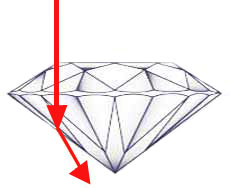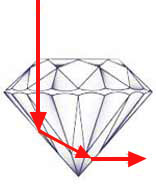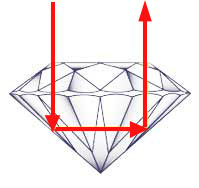Diamond Cut
“Cut” refers to the shape of a diamond and its mathematical proportions. The most popular shapes are Round, Princess, Emerald, Asscher, Marquise, Oval, Radiant, Pear, Heart and Cushion.
The cut of a diamond — its depth, table, width, the uniformity of its facets — determines a diamond's brilliance.
Even if a diamond has perfect color and clarity, it will have dulled brilliance if it has a poor cut.
In an ideal cut, all of the light that enters the stone refracts internally from precisely placed facets and disperses through the top of the diamond, producing maximum sparkle and brilliance. When a stone is cut too shallow or too deep, the light that enters through the top escapes through the bottom and does not allow the maximum beauty of the diamond to be realized.
Just because two diamonds have the same weight does not mean they are the same diameter. For example, a well-cut 1-carat. Round diamond should be about 6.4 mm in diameter. However, many 1-carat. diamonds that measure 6.00 mm (deep cut) to 6.7 mm (shallow cut) are quite prevalent in the market.
Too Shallow: Light is lost from the sides causing the diamond to lose brilliance and resulting in a dark glassy appearance.

Too Deep: Light escapes from the bottom causing the diamond to appear dark in the centre.

Ideal Cut Round Diamond
Depth: 59.8% -62.8%, Table: 53%-58%, Polish & Symmetry Very Good or
Excellent
Premium Cut Round Diamond
Depth: 59%-63.3%, Table: 53%-61%, Polish & Symmetry Very Good or Good
Good (Average)Cut Round Diamond
Depth: 57.5%-64%, Table: 52%-64%, Polish & Symmetry Good

In round diamonds the two prime factors in assessing cut quality are depth and table. In the fancy shapes diamonds - Princess, Emerald, Asscher, Marquise, Oval, Radiant, Pear, Heart, Cushion (all except round diamond), brilliance is achieved through the interaction between depth, table, and length-to-width ratio. For example, two pear shape diamonds with identical depth and table values could look remarkably different depending on their depths. There is no magic formula to determine brilliance.



